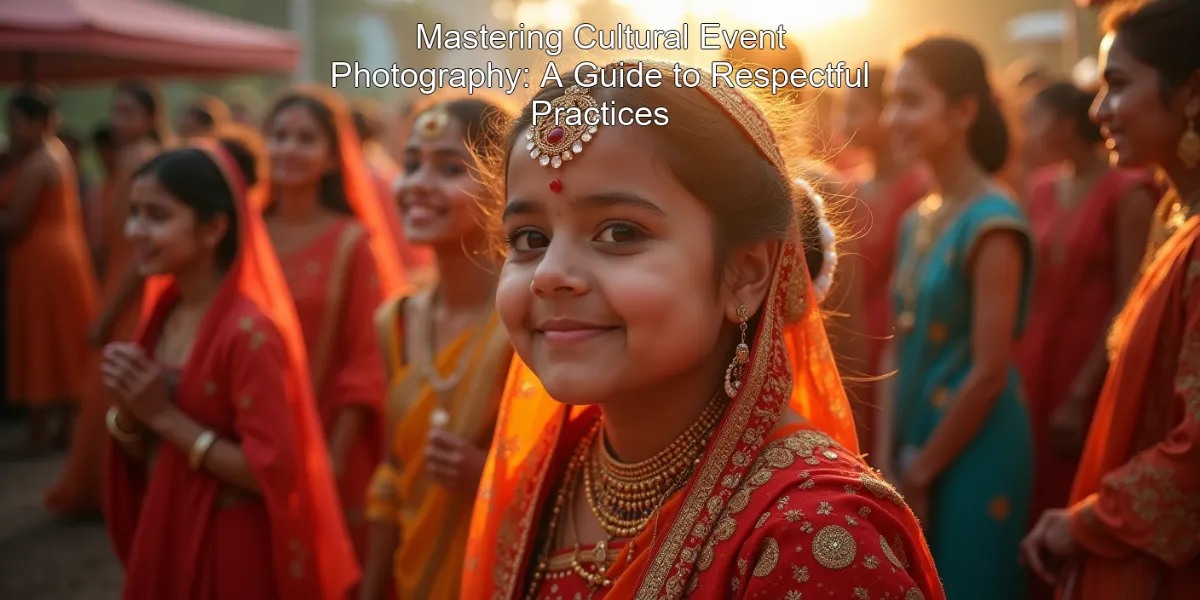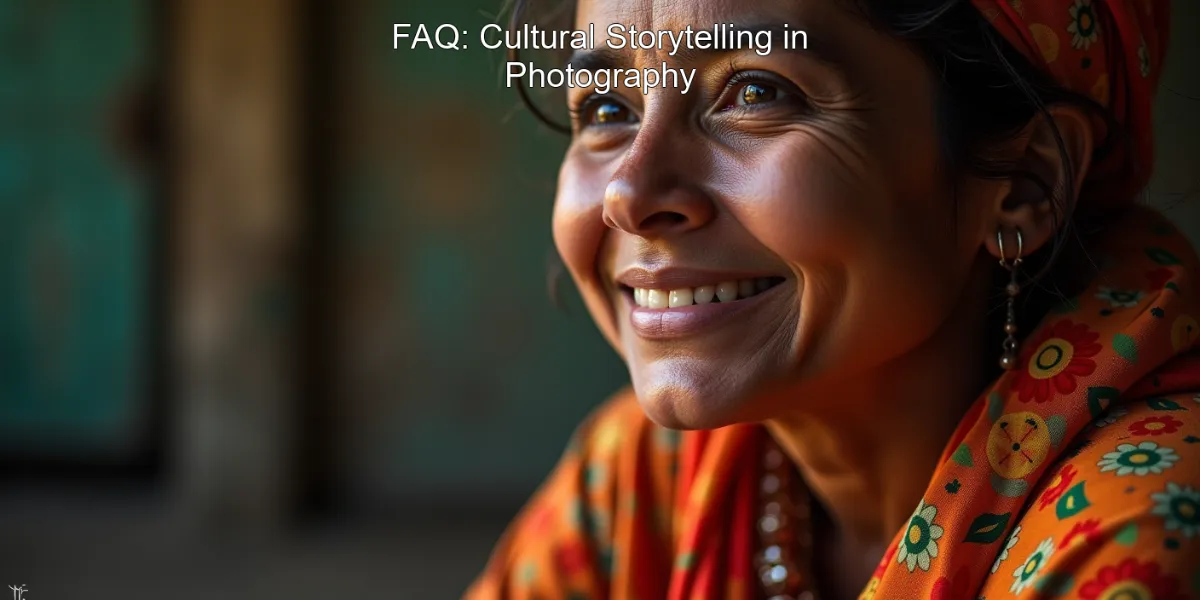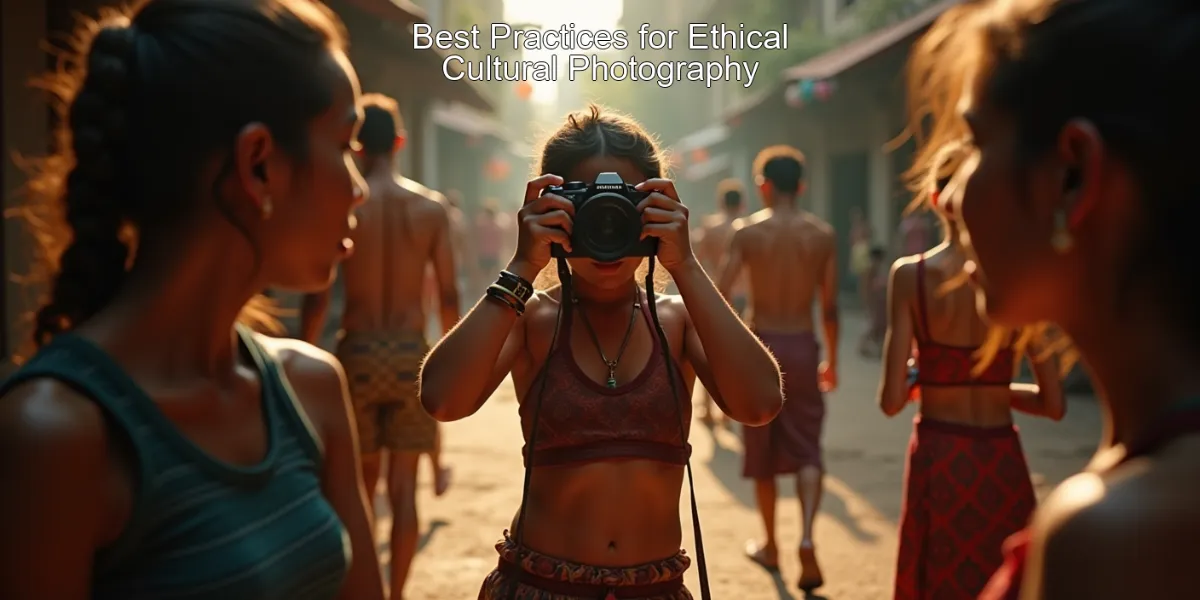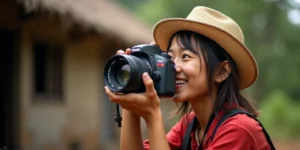Mastering Cultural Event Photography: A Guide to Respectful Practices

Capturing the vibrant essence of cultural events and traditions through photography is an art that requires both skill and sensitivity. As photographers, we have the power to immortalize moments that showcase the rich tapestry of human diversity. However, it’s crucial to approach this task with respect and cultural awareness. Let’s explore the best practices for photographing cultural events that will help you create stunning images while honoring the traditions you’re documenting.

“Capturing Culture: Best Practices for Respectful and Vibrant Event Photography”
#PhotographyTips, #CulturalRespect, #TravelPhotography
Key Considerations for Cultural Event Photography
| Aspect | Best Practice |
|---|---|
| Permission | Always seek consent before photographing individuals or private ceremonies |
| Research | Study the cultural significance of the event beforehand |
| Dress Code | Adhere to appropriate attire for the event |
| Behavior | Be unobtrusive and respectful of sacred moments |
Essential Steps for Respectful Cultural Photography
- Research the event’s cultural significance and any photography restrictions
- Obtain necessary permits or permissions from event organizers
- Dress appropriately to blend in with the crowd
- Use silent shooting mode on your camera when possible
- Respect personal space and sacred areas
- Be mindful of your body language and facial expressions
“The camera is an instrument that teaches people how to see without a camera.” – Dorothea Lange
This quote reminds us that photography is not just about taking pictures, but about truly seeing and understanding the world around us. When it comes to cultural events, this perspective is invaluable.
Frequently Asked Questions
Q: How do I approach people for portraits during cultural events?
A: Always ask for permission first, explain your purpose, and show respect for their decision.
Q: Are there any universal taboos in cultural event photography?
A: Avoid photographing sacred rituals without explicit permission, and never use flash during solemn ceremonies.
Q: How can I ensure my photos are culturally sensitive?
A: Research the culture beforehand, consult with local guides, and be open to feedback from community members.
Tips for Capturing Authentic Cultural Moments
- Use a longer lens to maintain distance and avoid disrupting the event
- Capture candid moments that showcase genuine emotions
- Focus on details that represent the culture’s unique aspects
- Incorporate environmental elements to provide context
- Be patient and wait for the perfect moment rather than forcing shots
According to a survey by the World Photography Organisation, 78% of cultural event photographers say that building rapport with subjects is crucial for capturing authentic images. This statistic underscores the importance of human connection in cultural photography.
As you embark on your journey to photograph cultural events, remember that your role is not just to document, but to bridge understanding between cultures. By following these best practices, you’ll not only create compelling images but also foster respect and appreciation for the diverse traditions you encounter.
For more insights on immersing yourself in different cultures through travel, check out our Cultural Immersion guide. And if you’re looking to elevate your travel photography skills, don’t miss our Travel Tips & Hacks section for expert advice.
Whether you’re capturing the vibrant colors of a festival or the quiet moments of a traditional ceremony, approach each opportunity with reverence and curiosity. Your photographs have the power to tell stories that transcend borders and connect hearts across the globe. So pack your camera, open your mind, and set out to capture the beauty of our world’s cultural tapestry with respect and admiration.
Understanding Cultural Sensitivity in Photography
| Key Aspects | Importance |
|---|---|
| Respect | Essential |
| Permission | Crucial |
| Cultural awareness | Vital |
When it comes to capturing the essence of diverse cultures and traditions through photography, respect is paramount. Consider these key points:
- Research local customs and taboos
- Always ask for permission before taking photos
- Be mindful of sacred or sensitive locations
- Dress appropriately for the cultural context
“The camera is an instrument that teaches people how to see without a camera.” – Dorothea Lange
According to a survey by the World Tourism Organization, 78% of travelers believe that respecting local cultures is crucial for sustainable tourism.
FAQ: Respectful Cultural Photography
Q: How do I ask for permission to photograph someone?
A: Learn basic phrases in the local language, use respectful body language, and be prepared to accept ‘no’ as an answer.
Q: Are there universal gestures to indicate I want to take a photo?
A: While pointing to your camera and smiling is often understood, it’s best to verbally ask for permission when possible.
Q: What should I do if I accidentally offend someone while taking photos?
A: Apologize sincerely, delete the photo if requested, and use it as a learning experience for future interactions.
Tips for Ethical Cultural Photography
- Educate yourself about the culture before your trip
- Engage with locals and show genuine interest in their traditions
- Offer to share your photos with the subjects
- Be discreet during religious ceremonies or private moments
- Consider the impact of your presence on the community
A study by the International Journal of Tourism Research found that 65% of cultural sites reported issues with disrespectful photography practices.
Mastering the Art of Cultural Storytelling Through Images
| Storytelling Element | Photographic Technique |
|---|---|
| Context | Wide-angle shots |
| Emotion | Candid portraits |
| Detail | Macro photography |
Capturing the essence of a culture goes beyond mere snapshots. It’s about weaving a visual narrative that respects and celebrates diversity. Consider these approaches:
- Focus on authentic moments rather than staged scenes
- Use natural light to enhance the mood and atmosphere
- Incorporate local artifacts and symbols in your compositions
- Seek to capture the everyday life alongside special events
“Photography is a way of feeling, of touching, of loving. What you have caught on film is captured forever… it remembers little things, long after you have forgotten everything.” – Aaron Siskind
The National Geographic Society reports that images depicting cultural traditions receive 42% more engagement on social media platforms compared to other travel photos.
FAQ: Cultural Storytelling in Photography

Q: How can I capture the essence of a culture without stereotyping?
A: Focus on individual stories and diverse aspects of daily life, avoiding clichéd or overly exotic portrayals.
“Authentic Cultural Photography: Celebrating Individual Stories and Daily Life”
Q: What’s the best way to photograph cultural festivals?
A: Arrive early to understand the event’s flow, respect any photography restrictions, and capture both wide scenes and intimate details.
Q: How do I balance artistic expression with cultural sensitivity?
A: Prioritize the dignity and wishes of your subjects over getting the “perfect shot,” and always be open to learning from the community.
Best Practices for Cultural Photography
- Learn about the historical and social context of the traditions you’re photographing
- Collaborate with local guides or cultural experts for deeper insights
- Use captions to provide accurate context for your images
- Consider how your photos might impact the community’s perception of itself
- Give back to the community by sharing your work or supporting local initiatives
A recent study by the Cultural Immersion Institute found that photographers who engage in pre-trip cultural education produce images that are 30% more positively received by the local communities they visit.
Navigating Ethical Challenges in Cultural Photography
| Ethical Concern | Mitigation Strategy |
|---|---|
| Exploitation | Fair compensation |
| Misrepresentation | Accurate captioning |
| Privacy invasion | Informed consent |
Ethical considerations are crucial when photographing cultures and traditions. Here are some key points to keep in mind:
- Be transparent about your intentions and how the photos will be used
- Avoid photographing vulnerable populations without proper safeguards
- Consider the long-term impact of your images on the community
- Respect local laws and regulations regarding photography
“The only rule in photography is that there are no rules.” – Paul Strand
However, when it comes to cultural photography, ethical guidelines are essential. The World Press Photo Foundation reports that 82% of photojournalists believe that ethical standards in cultural photography have improved in the last decade.
FAQ: Ethical Cultural Photography
Q: Should I pay people to take their photograph?
A: It’s a complex issue. If payment is expected, consider fair compensation or supporting local businesses instead.
Q: How can I ensure my photos don’t perpetuate harmful stereotypes?
A: Seek diverse perspectives, provide context, and challenge your own biases before sharing images.
Q: What should I do if I witness unethical photography practices?
A: Respectfully educate others if possible, and always prioritize the well-being of the local community.
Ethical Guidelines for Cultural Photographers
- Develop a personal code of ethics for your photography practice
- Seek informed consent, especially for close-up portraits or sensitive subjects
- Be prepared to put the camera away and simply experience the culture
- Use your platform to amplify local voices and perspectives
- Continuously educate yourself on cultural sensitivities and ethical practices
The International Center of Photography found that photographers who adhere to strict ethical guidelines report 40% higher satisfaction with their work and stronger relationships with the communities they photograph.
For more insights on ethical travel practices, check out our Travel Tips & Hacks
<h2Capturing Cultural Moments: A Guide to Respectful Photography
Photographing diverse cultures and traditions can be an enriching experience, but it requires sensitivity and respect. Let’s explore how to capture these moments ethically and meaningfully.
| Key Aspects | Importance |
|---|---|
| Cultural Sensitivity | High |
| Permission | Essential |
| Respect for Customs | Crucial |
Essential Steps for Ethical Cultural Photography
- Research local customs and taboos before your trip
- Always ask for permission before taking photos
- Be mindful of sacred sites and ceremonies
- Avoid exploitative or stereotypical portrayals
“The camera is an instrument that teaches people how to see without a camera.” – Dorothea Lange
According to a survey by the World Tourism Organization, 78% of travelers believe that respecting local cultures is crucial for sustainable tourism.
Q: How do I ask for permission to photograph someone?
A: Learn basic phrases in the local language, use respectful body language, and be prepared to accept ‘no’ as an answer.
Q: Are there specific cultural events I should avoid photographing?
A: Yes, some religious ceremonies or rituals may be off-limits. Always research and ask local guides for advice.
Q: How can I give back to the communities I photograph?
A: Consider sharing prints, supporting local businesses, or contributing to community projects.
- Immerse yourself in the culture before taking photos
- Focus on storytelling rather than just aesthetics
- Use natural light to capture genuine moments
- Learn about the significance of cultural symbols and rituals
A study by the International Journal of Tourism Research found that 65% of travelers feel more connected to a destination when they engage respectfully with local cultures.
Navigating Cultural Sensitivities in Photography
Understanding cultural nuances is crucial for capturing authentic and respectful images. Let’s delve deeper into this aspect of travel photography.
| Cultural Aspect | Consideration |
|---|---|
| Dress Codes | Respect local norms |
| Religious Sites | Follow specific rules |
| Personal Space | Vary by culture |
Dos and Don’ts of Cultural Photography
- Do: Learn about local etiquette and customs
- Don’t: Intrude on private moments or spaces
- Do: Engage with people before photographing them
- Don’t: Use photos for commercial purposes without consent
“To photograph is to hold one’s breath, when all faculties converge to capture fleeting reality.” – Henri Cartier-Bresson
The Ethical Traveler organization reports that 82% of responsible tourists prioritize cultural respect in their travel practices, including photography.
Q: How can I photograph markets without being intrusive?
A: Use a wider lens, ask vendors for permission, and consider purchasing items from those you photograph.
Q: What should I do if someone asks for payment for a photo?
A: Respect their request and either pay or politely decline to take the photo.
Q: How can I capture candid moments without being disrespectful?
A: Spend time in an area, become familiar to locals, and use a longer lens to maintain distance.
Best Practices for Ethical Cultural Photography

- Educate yourself about the culture’s history and current issues
- Collaborate with local photographers or guides
- Share your photos with the community when possible
- Be mindful of the story your images tell about the culture
A recent study by the Cultural Immersion Institute found that travelers who engage in respectful photography practices report 40% higher satisfaction with their travel experiences.
Key Insights
Remember, ethical photography is about creating connections and understanding, not just capturing images. By following these guidelines, you’ll not only take better photos but also contribute to more meaningful Adventure Escapes and cultural exchanges.
For more insights on responsible travel practices, check out our Travel Tips & Hacks section. And if you’re looking to combine cultural photography with comfort, explore our Luxury Retreats that offer unique cultural experiences.




